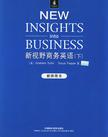新视野商务英语(下)
出版时间:2003-8 出版社:外语教学与研究出版社 作者:塔利斯 页数:104
前言
《新视野商务英语(下)》是一门针对经济类专业大学生和商界人士的中高级综合课程。它为人们理解当代商务活动中的关键领域提供了真实的环境,同时使学生通过一系列形式多样、充满挑战的相关练习提高他们的语言技能。为确保本书的内容贴近现实,每一单元都是与国际知名公司或机构通力协作进行编写的。本课程符合商务学习课程教学大纲和课程设置的要求,是参加国际商务英语考试的理想准备用书。 教师用书 关键词汇(Key vocabulary) 这是一个简短的介绍性部分,目的是使学生熟悉本单元的主题,并对核心单词加以解释。关键词或带有相应的释义,或通过上下文可以轻易推断出其含义。 主题可以口头向学生传达,也可以要求学生说出他们已经知道的相关单词。尤其是对于大班来说,可以要求学生对本部分进行预习。对于本部分重点强调的单词,可以通过把它们写在黑板上的方法来引起学生的注意。在进行本单元的其他内容之前,要检查学生对这些单词的理解情况。对于本书68-75页上提供的关键词汇练习,可以给学生相关的复印材料进行练习,也可在一个单元即将结束时使用,以保证进行下一单元之前,学生掌握了最重要的词汇。 引导(Lead-in) 引导部分鼓励学生对单元主题进行思考。可以采取不同的形式,从听力练习到谈话演讲,这些活动可通过小组工作或讨论的形式来进行,鼓励学生讲出他们的有关经历或者已经了解的知识。教师用书提供了关于如何使用这些材料的具体方法。 阅读(Reading) 书中阅读部分都取自英国、爱尔兰或美国的报纸、商业出版物或公司宣传材料。其中一些材料提供了对单元主旨的概括和见解,而另外一些材料的入选则是因为它们从独特的视角出发表达了对人物或事件的看法。这些阅读材料长短不一,难度各异,既可以在课堂上使用,也可以提前进行准备。通过相应的练习题.可以检验学生的理解程度,练习包括判断正误、选择题测试和填网络表格题。 词汇(Vocabulary) 在阅读材料之后会有两三道词汇练习题,前一、两道用来测试学生对阅读材料中与主题相关词汇的理解,通过包括定义连线题、寻找同义词或反义词、构词和纵横字谜在内的多种形式来进行。最后一种练习是在不同的上下文中使用这些词汇,通过练习证明学生能够使用这些新词语。鼓励学生使用英英词典。 讨论(Dicussion) 所有单元都有鼓励讨论的活动,其中包含一些特殊的讨论部分,鼓励全班作为一个整体去学习表达与阅读材料主题相关的看法和意见。在一些单元中,会有一系列激发学生讨论的问题,而其它单元则会要求学生对文档、信息或案例发表评论。 语言重点(Language focus) 《新视野商务英语(下)》含有标准语法结构纲要,中高级学生应该已经掌握,但是需要在练习中经常进行温习。语言重点部分涉及到一种或多种语法结构,并鼓励学生在商务环境中思考这些语法要点。练习部分使学生能够巩固他们的知识。对这些语法结构的全面解释安排在学生用书后面的语法参考部分。某些单元中的附加练习题侧重于以前阅读材料中出现的特定语法问题。所有示例均基于取自不同渠道的实际信息,可以提高学生对单元整体主题的理解。语法练习也可以布置为课后作业,然后在课堂上加以更正。
内容概要
《新视野商务英语》根据语言难度分为上、下两册,每册分别由学生用书、教师用书和练习册三部分组成。 《新视野商务英语(下)》适用于中、高级英语水平的商务专业学生及商界人士。既可独立使用,也可作为《新视野商务英语(上)》的高级教程使用。掌握这套教材中的基本语言和商务技能,将有助于您顺利通过BEC 、LCCI和TOEIC等国际商务英语考试。 《新视野商务英语(下)》以交际教学法为原则,提供了系统的语言规则和真实案例,能切实帮助学生提高在商务活动中的实战能力和技巧。内容特色:提供商务英语模拟试题;每单元均提供教案和背景知识;提供录音脚本和练习答案;
书籍目录
学生用书目录前言1、公司结构2、招聘3、零售业4、特许经营5、国际商业风格复习1答案6、银行业7、商业与环境8、股票市场9、进出口10、公司业绩复习2答案11、设立企业12、公司联合与收购13、市场营销14、产品与公司广告15、商业媒体复习3答案可复印资料测验 诊断性测验 期中测验 期末测验可复印资料答案
章节摘录
Unit 14 Product and Corporate Advertising Key vocabulary Illustrate the key vocabulary with examples of both product and corporate advertising. Show students examples of product advertisements in magazines and elicit the word advertisement from them. Explain that we say an advertisement and not an advertising. Ensure that students understand the difference in meaning and pronunciation of the words advertise, advertiser, advertising and advertisement. You may wish to use the photocopiable vocabulary exercise on page 74 to check that students understand the crucial terms. To illustrate corporate advertising, you could use either a job offer which gives information about the company and their policies or a similar one to the BP corporate advertisement on page 143 of the Students Book. Ask students to think of methods of communication companies use to make their policy and attitudes known to the public. These can include company websites, annual reports, newspaper articles and sponsorship of international or local sport and cultural events. Explain that these are designed to generate positive publicity about the company. If students have problems understanding the difference between publicity and advertising, point out that some publicity can be negative as we cannot always control what people will say or write about a company (although some consider that all publicity is good publicity, and you may want to mention Benettons advertising campaign briefly at this stage--using controversial images which deliberately draw a great deal of public criticism. An example of a major company destroyed by bad publicity in the UK is Ratners, the high street jewellery chain--its founder spoke openly about the poor quality of its cheaper products and the company collapsed as a result of the backlash). Give an example of negative publicity such as if a Boeing plane crashes, the companys name will be headline news in every newspaper and news programme. Advertising is ordered and paid for by a company and its aim is always to increase sales by creating positive attitudes towards the products being advertised. Lead-in 1 The purpose of this section is to get students to think about different advertising media. Groups can brainstorm ways that companies advertise their products and services. These include a wide variety of print, broadcast media (TV, radio and the cinema), outdoor advertising (posters, hoardings [billboards], displays of logos at stadiums and on clothes, and skywriting), transportation advertising (racing cars, and signs on public transport vehicles and stations), point of sale advertising (window displays, product demonstrations and stands in supermarkets), websites and sales through e-commerce, and other printed media (carrier bags, calendars, matchbooks, pens, etc.). Gather together the various ideas on the board. 2 Use this discussion activity to encourage students to think about the latest trends in advertising such as free advertisements from Internet providers and virtual advertising. Encourage them to talk about their favourite ads and advertising methods. Discuss whether they find the four methods mentioned appealing or not. Ask them to think about other innovative ways to advertise such as small screens at petrol pumps at filling stations. 3 These activities are designed to have fun with slogans. You may want to display various slogans and ask students to discuss and select the best. It might be fun to ask students to translate some of them into their own languages and discuss the results. They will no doubt discover the difficulties in translating humour and word-plays, so often found in slogans. 1 The examples in the text are taken from the Internet and should provoke a discussion on the problems of international or global advertising. Ask students to read the examples and say how they would react to products bearing these slogans. 2 Students now work in groups to translate popular slogans in their language into English. They may also wish to invent new slogans in English for products. To help them, it might be productive to circulate magazines or suggest topic areas such as chocolates, beer, sportswear, perfume and shampoo. 4 This discussion task is designed to get students to talk about provocative and sometimes offensive advertising. As a preparation for the reading text, it may also be useful to ask them if they think this example from Benetton has the same affect on all age groups, or whether certain generations find it more acceptable than others, and why. You may want to include another example such as French Connections use of FCUK on casual clothes and hoardings in Britain aimed at their young adult market.
编辑推荐
提供商务英语模拟试题; 每单元均提供教案和背景知识; 提供录音脚本和练习答案;
图书封面
评论、评分、阅读与下载
用户评论 (总计10条)
- 第二天就到了,不错!可惜没有磁带!
- 书挺好,非常满意
- 很棒的教科书
- 说实话,书挺好的,就是平邮太慢了呵呵
- 挺好的书,老师正在用它
- 我认为还不错,有听力原文还有学生用书的答案,而且还有一些可复印的补充练习,供我参考.
- 还行~纸质不错~价格也还好~但是答案不是很详细~
- 买来和我现在用的教科书一起用的。希望对我的学习会有帮助。
- 因为在自学所以买了还不错
- 里面的内容没有想象中的详尽,只是些听力原文和课后题解之类!后面有些例文,感觉还不错!学好新视野还是要靠自己呀!!
